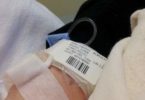The medical term for nosebleed is epistaxis. We can also say nasal hemorrhage. The human nose, and those of many animals are rich in blood vessels. Because of the position of the nose – right in the middle of the face and all its blood vessels, most of us will have had at least one nosebleed at some time during our lives.
Nosebleeds are seldom a cause for alarm but can be life threatening in rare cases. Spontaneous nosebleeds are fairly common, especially in children. When the mucous membrane (a mucus-secreting tissue) inside the nose dries, crusts, or cracks (the skin splits open) and is then picked, it is likely to bleed. Because the nose is full of blood vessels and is inconveniently situated in the middle of the face, any minor injury to the face can cause the nose to bleed profusely.
Nosebleeds are also common in people taking anti-coagulants (blood-thinning medications, such as Aspirin), as well as in older people whose blood may take longer to clot. If the patient is taking anti-coagulants, has hypertension (high blood pressure), or a blood-clotting disorder, the bleeding may be harder to stop and could last over 20 minutes.
Causes
There are many causes of nosebleeds. A sudden or infrequent nosebleed is rarely serious, but if you have frequent nosebleeds, you could have a more serious problem.
Dry air is the most common cause of nosebleeds. Living in a dry climate and using a central heating system can dry out the nasal membranes, which are tissues inside the nose. This dryness causes crusting inside the nose. Crusting may itch or become irritated, and if scratched or picked, the nose can bleed.
Taking antihistamines and decongestants for allergies, colds, or sinus problems can also dry out the nasal membranes and cause nosebleeds. Frequent nose blowing is another cause of nosebleeds.
Other common causes of nosebleeds include:
- object stuck in the nose
- chemical irritants
- allergic reaction
- injury to the nose
- repeated sneezing
- nose picking
- cold air
- upper respiratory infection
- large doses of aspirin
Other causes of nosebleeds include high blood pressure, a bleeding disorder, blood clotting disorder, and cancer.
Most nosebleeds do not require medical attention. However, you should seek medical attention if your nosebleed lasts longer than 20 minutes or occurs after an injury. This may be a sign of a posterior nosebleed.
Injuries that might cause a nosebleed include a fall, a car accident, or a punch in the face. Nosebleeds that occur after an injury may indicate a broken nose, skull fracture, or internal bleeding.
Symptoms
Bleeding usually occurs from only one nostril. If the bleeding is heavy enough, the blood can fill up the nostril on the affected side and overflow within the nasopharynx (the area inside the nose where the two nostrils merge), spilling into the other nostril to cause bleeding from both sides. Blood can also drip back into the throat or down into the stomach, causing a person to spit or even vomit blood.
Signs of excessive blood loss include dizziness, light-headedness, confusion, and fainting. Excessive blood loss from nosebleeds is rare.
Additional bleeding from other parts of the body, such as bleeding gums when brushing teeth, blood in urine or bowel movements, or easy bruising may indicate an inability of the blood to clot. Additional bleeding or easy bruising can be a sign of a more significant medical problem.
Treatment
- Sit upright and lean forward. By remaining upright, you reduce blood pressure in the veins of your nose. This discourages further bleeding. Sitting forward will help you avoid swallowing blood, which can irritate your stomach.
- Pinch your nose. Use your thumb and index finger to pinch your nostrils shut. Breathe through your mouth. Continue to pinch for five to 10 minutes. Pinching sends pressure to the bleeding point on the nasal septum and often stops the flow of blood.
- To prevent re-bleeding, don’t pick or blow your nose and don’t bend down for several hours after the bleeding episode. During this time remember to keep your head higher than the level of your heart.
- If re-bleeding occurs, blow out forcefully to clear your nose of blood clots and spray both sides of your nose with a decongestant nasal spray containing oxymetazoline (Afrin, Mucinex Moisture Smart, others). Pinch your nose again as described above and call your doctor.
You can self-treat a nosebleed at home. While sitting up, squeeze the soft part of your nose. Make sure that your nostrils are fully closed. Keep your nostrils closed for 10 minutes, lean forward, and breathe through your mouth.
Do not lie down when trying to stop a nosebleed. Lying down can result in swallowing blood and can irritate your stomach. Release your nostrils after 10 minutes and check to see if the bleeding has stopped. Repeat these steps if bleeding continues.
You can also apply a cold compress over the bridge of your nose or use a nasal spray decongestant to close off the small blood vessels.
See a doctor if you’re unable to stop a nosebleed on your own. If a foreign object caused your nosebleed, your doctor can remove the object. A medical technique called cauterization can also stop persistent or frequent nosebleeds. This involves your doctor burning the blood vessels in your nose with silver nitrate (a compound used to remove tissue) or a heating device. Your doctor may also pack your nose with cotton or gauze to apply pressure to your blood vessels and stop bleeding.
Call an emergency if:
- The bleeding lasts for more than 20 minutes
- The nosebleed follows an accident, a fall or an injury to your head, including a punch in the face that may have broken your nose





